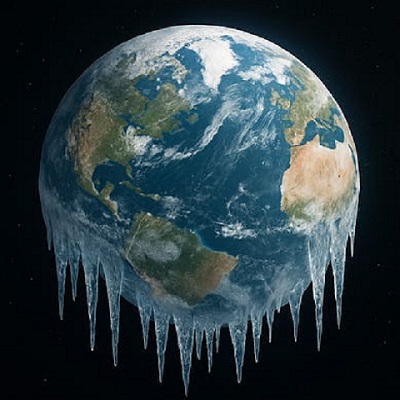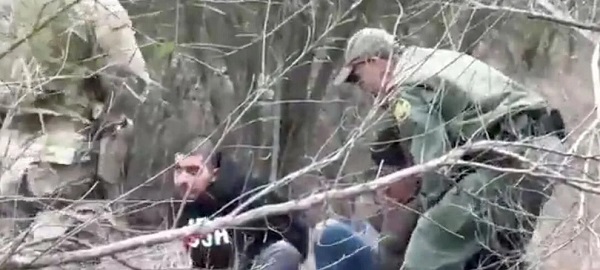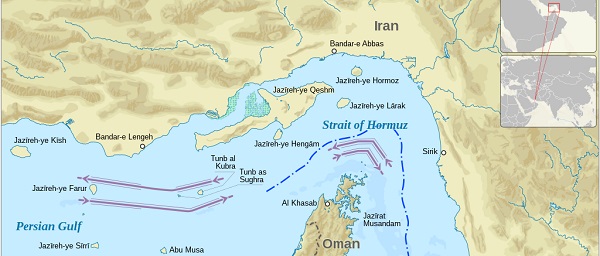International
Ice Surprises – Arctic and Antarctic Ice Sheets Are Stabilizing and Growing

 The Honest Broker
The Honest Broker  Roger Pielke Jr.
Roger Pielke Jr.
New climate research in science and policy context
Earlier this week the New York Post asked me to help its readers make sense of some surprising new research on ice dynamics at both poles. The new research appears in a new peer-reviewed paper and a preprint that was just posted.
At the South Pole, Wang et al. 2025 find a record accumulation of ice on the Antarctic ice sheet over the period 2021 to 2023, following a steady decrease from 2002 to 2021. The data comes from NASA’s GRACE series of satellites, which have the ability to precisely measure ice mass.
The figure below shows that the recent accumulation is small in the context of the multi-decadal decline, but is still characterized by the paper’s authors as a “significant reversal.” The paper makes no predictions of whether or how long the accumulation might continue.
At the other end of the planet, at the North Pole, a new preprint by England et al. identifies a “surprising, but not unexpected multi-decadal pause in Arctic sea ice loss.”¹ Their data can be seen below.
 |
From the caption to the figure: “(a,b )Observed sea ice area [106 km2] 1979-2024, (c,d) 20 year-trends of September sea ice area [106 km2/decade] with varying end year from 1998 to 2024, in which the red shaded envelope shows the bounds inside which a linear trend is not statistically significant according to a t-test at 95% confidence.” Source: England et al.
Disucssing these new papers and their significance, my op-ed for the NY Post starts as follows:
When it comes to climate change, to invoke one of Al Gore’s favorite sayings, the biggest challenge is not what we don’t know, but what we know for sure but just isn’t so.
Two new studies show that the Earth’s climate is far more complex than often acknowledged, reminding us of the importance of pragmatic energy and climate policies.
One of them, led by researchers at China’s Tongji University, finds that after years of ice sheet decline, Antarctica has seen a “surprising shift”: a record-breaking accumulation of ice.
The paper takes advantage of very precise measurements of Antarctic ice mass from a series of NASA satellites called GRACE (Gravity Recovery and Climate Experiment).
Since the first GRACE satellite was launched in 2002, Antarctica has seen a steady decline in the total mass of its glaciers. Yet the new study found the decline reversed from 2021 to 2023.
Melting Antarctic ice contributes to global sea-level rise, so a reversal of melting will slow that down. Understanding the dynamics of ice mass on Antarctica is thus essential.
The recent Antarctica shift makes only a small dent in the overall ice loss from 2022, but comes as a surprise nonetheless.
A second new paper, a preprint now going through peer review, finds a similar change at the opposite end of the planet.
Antarctic ice has made a turnaround, scientists say, with an increase in ice mass after years of depletion.
Antarctic ice has made a surprising rebound in mass, scientists say
“The loss of Arctic sea ice cover has undergone a pronounced slowdown over the past two decades, across all months of the year,” the paper’s US and UK authors write.
They suggest that the “pause” in Arctic sea ice decline could persist for several more decades.
Together, the two studies remind us that the global climate system remains unpredictable, defying simplistic expectations that change moves only in one direction.
In 2009, then-Sen. John Kerry warned that the Arctic Ocean would be ice-free by 2013: “Scientists tell us we have a 10-year window — if even that — before catastrophic climate change becomes inevitable and irreversible,” he said.
Today, six years after that 10-year window closed, catastrophic climate change has not occurred, even as the planet has indeed continued to warm due primarily to the combustion of fossil fuels.
Partisans in the climate debate should learn from Kerry’s crying wolf.
On one side, catastrophizing climate change based on the most extreme claims leads to skepticism when the promised apocalypse fails to occur on schedule.
On the other side, studies like the two surprising polar-ice papers reveal climate complexities, but don’t prove climate change isn’t real and serious. . .
This last point is important — climate research is not a scoreboard in a Manichean debate, but instead offers certainties, uncertainties, and even areas of total ignorance that establish a nuanced context for developing robust mitigation and adaptation policies.
The rest of my piece discusses this context. Please head over to the NY Post to read the whole thing and then come back to THB and tell me what you think.
One bit of my original draft was cut for space reasons. Here is that part:
Core understandings of climate science have remained remarkably constant over many decades – Humans affect the climate system in many ways, including greenhouse gas emissions, but also through land management, air pollution, and vegetation dynamics. At a planetary scale the net effect of these changes – driven by carbon dioxide emissions from the burning of coal, natural gas, and oil – is a warming of the planetary system. Anticipating regional and local consequences is far more challenging.
Irreducible uncertainties mean that climate variability and change are about risk management. As the late climate scientist Steve Schneider lamented in 2002, “I readily confess a lingering frustration: uncertainties so infuse the issue of climate change that it is still impossible to rule out either mild or catastrophic outcomes, let alone provide confident probabilities for all the claims and counterclaims made about environmental problems.”
Risk management means that as we balance competing objectives in energy policy we should look for opportunities to reduce costs, increase access, ensure security and reduce the human influences on the environment.
The published version ends with may call for policy makers to keep their eyes on the ball:
The surprises revealed by the two new papers about polar ice also remind us that we need to be prepared for unexpected behavior of the climate system, regardless of the underlying causes of change.
History tells us that climate can shift abruptly, with profound consequences for society.
For instance, the 1870s saw a wide range of climate extremes across the planet, by some estimates contributing to the deaths of 4% of global population.
More recently, the climate extremes of the 1970s led to many new US government programs focused on monitoring and researching climate, such as the National Oceanic and Atmospheric Administration.
Such efforts are crucially important because we can’t always anticipate the results of research. If we could, we wouldn’t need data and science.
Perhaps the most important lesson to take from the new polar-ice findings is that ongoing efforts in Washington, DC to gut climate data and research are deeply misguided.
The global climate system has more surprises in store for us — and we ignore them at our peril.
Read the whole thing here.
Next week here at THB and elsewhere, I’ll have much more on NOAA and current efforts to gut climate data and research.
Before letting you go today — last week I sat down with John Hook from Fox 10 in Phoenix and engaged in a deep discission of climate science and energy policy. You can see the full interview below. Thanks to John for the opportunity and the informed questions — I enjoyed the interview and the chance to explore nuances of climate and energy.
If you value the efforts here at The Honest Broker to contextualize science in policy and politics,
please consider subscribing, sharing, and supporting.
THB exists because of your support.
illegal immigration
Heightened alert: Iranians in U.S. previously charged with support for terrorism

Texas Department of Public Safety brush team apprehends gotaways and smuggler in Hidalgo County.
From The Center Square
By
Prior to President Donald Trump authorizing targeted strikes against Iranian nuclear sites on Saturday, federal agents and Texas Department of Public Safety troopers have been arresting Iranian nationals, nearly all men, in the U.S. illegally. In the last few months, federal prosecutors have also brought terrorism charges against Iranians, including those in the U.S. working for the Iranian government.
Iran is a designated state sponsor of terrorism. Iranian nationals illegally in the country are considered “special interest aliens” under federal law.
The U.S. Department of Homeland Security on Sunday issued a warning to all Americans to be on a heightened threat alert.
“The ongoing Iran conflict is causing a heightened threat environment in the United States,” DHS warned. “Low-level cyber attacks against US networks by pro-Iranian hacktivists are likely, and cyber actors affiliated with the Iranian government may conduct attacks against US networks.
“Iran also has a long-standing commitment to target US Government officials it views as responsible for the death of an Iranian military commander killed in January 2020.”
U.S. officials have no idea how many Iranians are in the U.S. illegally because at least two million “gotaways” were recorded entering the U.S. during the Biden administration. Gotaways are those who illegally entered the U.S. between ports of entry who were not apprehended.
Key arrests include an Iranian living in the sanctuary jurisdiction of Natick, Mass., who is charged “with conspiring to export sophisticated electronic components from the United States to Iran in violation of U.S. export control and sanctions laws,” The Center Square reported. Authorities accuse the Iranian of illegally exporting the technological equipment to a company in Iran that contracts with the Islamic Revolutionary Guard Corps (IRGC), a US-designated foreign terrorist organization (FTO). The company allegedly manufactured drones used by the IRGC that killed U.S. soldiers stationed in Jordan.
Texas DPS troopers have arrested dozens of Iranian special interest aliens. Last October, DPS troopers questioned Iranians who illegally entered the U.S. near Eagle Pass, Texas, who said they came through Mexico and were headed to Florida, Las Vegas and San Francisco, The Center Square reported.
Last November and December, DPS troopers arrested Iranians in Maverick County after sounding the alarm about an increase of SIAs they were apprehending, The Center Square reported.
U.S. Customs and Border Protection and Immigration and Customs Enforcement officers also apprehended an Iranian with terrorist ties who illegally entered the U.S. near Buffalo, New York, The Center Square reported.
More recently, in April, two Iranians were charged in New York with conspiring to procure U.S. parts for Iranian drones, conspiring to provide material support to the IRGC and conspiring to commit money laundering. They remain at large. The charges “lay bare how U.S.-made technology ended up in the hands of the Iranian military to build attack drones,” DOJ National Security Division chief Sue Bai said.
Also in April, two Iranians and one Pakistani, were indicted in Virginia “for conspiring to provide and providing material support to Iran’s weapons of mass destruction program resulting in death and conspiring to commit violence against maritime navigation and maritime transport involving weapons of mass destruction resulting in death.” The Pakistani is awaiting trial; the Iranians remain at large.
Their involvement in maritime smuggling off the coast of Somalia led to the death of two Navy SEALs, according to the charges.
Also in April, a naturalized citizen working for the Federal Aviation Administration as a contractor pleaded guilty to charges of “acting and conspiring to act as an illegal agent of the Iranian government in the United States” for a period of five years. He was indicted last December in the District of Columbia for “infiltrating a U.S. agency with the intent of providing Iran with sensitive information,” including exfiltrating sensitive FAA documents to Iranian intelligence.
“The brazen acts of this defendant – acting against the United States while on U.S. soil – is a clear example of how our enemies are willing to take risks in order to do us harm,” U.S. Attorney Edward Martin said. “We want to remind anyone with access to our critical infrastructure about the importance of keeping that information out of the hands of our adversaries. I want to commend our prosecutors and law enforcement partners who secured a guilty plea that will keep our country safer.”
Also in April, an Iranian national was indicted in Ohio for operating a dark web marketplace selling methamphetamine, cocaine, fentanyl, heroin and oxycodone and other drugs; and for stealing financial information, using fraudulent identification documents, counterfeit currencies, and computer malware. Working with German and Lithuanian partners, he was charged, servers and other infrastructure were seized, and drugs and other contraband were stopped from entering the U.S., DOJ Criminal Division head Matthew Galeotti said.
Also in April, ICE Homeland Security Investigations in New York announced a civil forfeiture action halting an Iranian oil sale scheme that went on for years under the Biden administration.
The scheme involved facilitating the shipment, storage and sale of Iranian petroleum product owned by the National Iranian Oil Company for the benefit of the IRGC and Islamic Revolutionary Guard Corps, designated FTOs. The facilitators allegedly claimed the Iranian oil was from Malaysia, manipulated tanker identification information, falsified documents, paid storage fees in U.S. dollars and conducted transactions with U.S. financial institutions. The federal government seized $47 million in proceeds from the sale.
The complaint alleges they provided material support to the IRGC and IRGC-QF because profits support “proliferation of weapons of mass destruction and their means of delivery, support for terrorism, and both domestic and international human rights abuses.”
Last December, a federal court in the District of Columbia ordered the forfeiture of nearly $12 million connected with Iran’s illicit petroleum industry, involving Triliance Petrochemical Company, the IRGC and Quds Forces. FBI Tampa and Minneapolis were involved in the investigation.
Examples also exist of Iranians making false statements when applying for naturalization, including an Iranian in Tampa indicted last year.
conflict
How Iran Could Shake Up Global Economy In Response To US Strikes


From the Daily Caller News Foundation
By Audrey Streb
Iran is reportedly weighing blocking a key commercial choke point known as the Strait of Hormuz, a move that could drive up energy costs in the U.S. and across the globe, according to energy sector experts who spoke with the Daily Caller News Foundation.
Israel began to bombard Iran to eliminate the Islamic Republic’s ability to build a nuclear weapon on June 13, and the U.S. carried out “Operation Midnight Hammer” on Saturday night, bombing three of Iran’s nuclear facilities. While Iran’s parliament has reportedly voted to close the Strait of Hormuz in a retaliatory move to choke the world’s oil supply in response to the American strikes, the U.S. is well-positioned to combat the inevitable energy cost spike that would follow if Iran succeeds, sector experts told the DCNF.
“The escalating conflict between Iran and Israel is already putting upward pressure on oil and natural gas prices—and that pressure will intensify if the Strait of Hormuz is blocked,” Trisha Curtis, an economist at the American Energy Institute, told the DCNF. “This kind of disruption would send global prices higher and tighten supply chains. Fortunately, the U.S. is well-positioned to respond — our domestic production strength and growing export infrastructure make American oil and natural gas increasingly indispensable to global markets.”
Iran does not have the legal authority to halt traffic through the strait, meaning it would need to usurp control through force or the threat of force, according to legal scholars and multiple reports. The Iranian parliament’s reported move to block the Strait on Sunday awaits final approval by Iran’s Supreme Council, according to Iran’s Press TV.
The Strait is only 35 to 60 miles wide and connects the Persian Gulf to the Indian Ocean, flowing past Iran, the United Arab Emirates and Oman. The thoroughfare is vital for global trade, as tankers carried one fifth of the world’s oil supply through the Strait of Hormuz in 2024 and the first quarter of 2025, according to data from the U.S. Energy Information Administration.
Roughly 20 million barrels of oil pass through the Strait of Hormuz on a daily basis, Curtis noted. Some liquified natural gas (LNG) exports would also be blocked if the Strait of Hormuz were closed, she said.
Iran has reportedly been warning that it could close the strait for weeks, with one Iranian lawmaker and a member of the parliament’s National Security Committee presidium both quoted as saying that Iran could respond to enemy attacks by disturbing the West’s oil supply. Maritime agencies and the U.K. Navy have advised ships to avoid the Strait in recent weeks, given the potential threat.
Other energy experts pointed to how the Russia-Ukraine war led to a worldwide spike in energy costs.
“Energy markets do not like war — they particularly do not like war in the Middle East,” Marc Morano, author and the head of Climate Depot told the DCNF. Morano noted that the impact of the war did not immediately spike energy costs in the U.S. and abroad, though further escalation could spike them — especially Iran moving to block the Strait. “Even rumors of a blockade could instill fear into energy markets and drive prices up,” Morano said.
Despite the threat of shipping through the Strait of Hormuz being blocked, the U.S. has some cushion, given that it is a net exporter of oil and gas, according to energy sector experts.
President Donald Trump has promoted a pro-energy-growth agenda that paves the way for domestic oil and gas expansion, which positions the U.S. to withstand intense conflict escalations or even the closure of the Strait, energy sector experts told the DCNF.
Such a blockage would make US oil and gas exports more important. It underscores the importance of Trump’s agenda — to open Alaska and other areas to energy production, to speed up infrastructure permitting, and to increase exports to our allies,” director of the Heritage Foundation’s Center for Energy, Climate, and Environment Diana Furchtgott-Roth told the DCNF.
Though the U.S. still imports oil from some nations in the Middle East, including those that use the Strait of Hormuz, the U.S. has the capacity to become the dominant oil producer, energy sector experts told the DCNF.
If Iran were to close the Strait it would amount to “economic suicide” as the nation’s economy is reliant on Hormuz, both Vice President JD Vance and Secretary of State Marco Rubio said in interviews on Sunday.
James Taylor, president of the Heartland Institute, told the DCNF that any disruption in the oil markets would lead to price increases, which only highlights the need for pro-energy policies domestically.
“It is very important for American policymakers to support rather than impede American oil production because America, as a dominant energy producer, will be largely immune to such political crises,” Taylor said. “In fact, if America is a dominant oil producer and Iran takes steps to shock the oil markets, America would benefit and Iran’s nefarious plan would backfire.”
-

 Alberta1 day ago
Alberta1 day agoCalls for a new pipeline to the coast are only getting louder
-

 Alberta1 day ago
Alberta1 day agoAlberta pro-life group says health officials admit many babies are left to die after failed abortions
-

 espionage1 day ago
espionage1 day agoFrom Sidewinder to P.E.I.: Are Canada’s Political Elites Benefiting from Beijing’s Real Estate Reach?
-

 Business1 day ago
Business1 day agoCanada’s economic pain could be a blessing in disguise
-

 Business1 day ago
Business1 day agoRhetoric—not evidence—continues to dominate climate debate and policy
-

 Energy1 day ago
Energy1 day agoEnergy Policies Based on Reality, Not Ideology, are Needed to Attract Canadian ‘Superpower’ Level Investment – Ron Wallace
-

 conflict1 day ago
conflict1 day agoU.S. cities on high alert after U.S. bombs Iran
-

 Business2 days ago
Business2 days agoHigh Taxes Hobble Canadian NHL Teams In Race For Top Players






